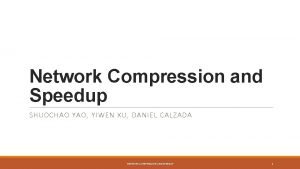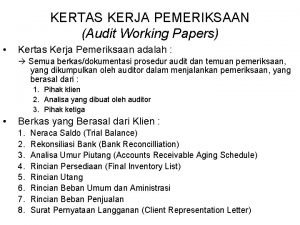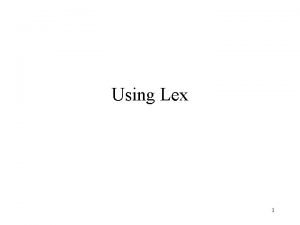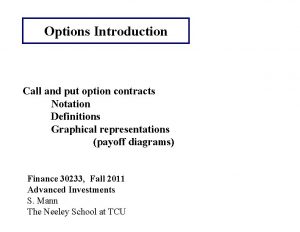Tutorial 1 Yufeng Yao Quiz Schedule Option A



































- Slides: 35

Tutorial 1 Yufeng Yao

Quiz Schedule Option A • Quiz 1: Week 4 Friday 16: 00 – 16: 20, 11 th Oct 2019 • Quiz 2: Week 9 Friday 16: 00 – 16: 20, 15 th Nov 2019 Or Option B • Quiz 1: Week 4 Friday 8: 00 – 8: 20, 11 th Oct 2019 • Quiz 2: Week 9 Friday 8: 00 – 8: 20, 15 th Nov 2019 We are following the majority rule.

10% Participation Mark • 9+1 • 9: Attendance and Participation mark (1 mark per week) • Attendance(0. 5 per week): 1. Attend tutorials 2. Focus on the class and not whisper to each other or play with your phone/laptop or leave early • Participation(0. 5 per week): 1. Constructive contribution to the tutorial discussion • 1: Bonus • More than 80% participation rate throughout the term

• Where to find my slides? • https: //yufengyao. wordpress. com/ • Upload by Friday

Specialness of financial intermediaries • Mutual fund • Information/monitoring costs • Economies of scale: 1. Individual VS Group 2. Avoid duplicate efforts • FI has a larger incentive to monitor their portfolios: 1. Regulation by government 2. Reputation • Liquidity costs • Diversified sources of fund • Price risk: FI has highly diversified portfolios. • Transaction costs: Economies of scale (FI has better connection with brokers)

Q 1 1. Which of the following is NOT a reason for the specialness of financial intermediaries? A. Lower average information costs. B. Lower price risk and superior liquidity attributes of financial claims to household savers. C. No agency costs. D. Lower average transaction costs. E. All of the above.

Answer: C • Agency costs exist between the principal and manager. • Agency costs always exist. • When managers work in the best interests of principals, agency costs do not exist. • In the real world, agency costs are very hard to avoid. • Managers not always work in the best interests of principals.

2. Which of the following statements is true? A. The RBA is responsible for market integrity and consumer protection across the financial system. B. APRA is responsible for prudential supervision. C. ASIC is responsible for monetary policy and for overall financial system stability. D. All of the above. E. None of the given answers.

Answer: B • APRA: Australian Prudential Regulation Authority • Prudential regulation and supervisions of the financial services industry • ASIC: Australia Securities and Investments Commission • Security market regulation such as market integrity, consumer protection, market behavior • RBA: Reserve Bank of Australia • Monetary policy

Identify and explain three economic disincentives that would dampen the flow of funds between household savers of funds and corporate users of funds in an economic world without financial institutions.

1. Monitoring cost • Extensive learning cost from financial market’s amateur to experts • Financial dataset 2. Liquidity cost • Long-term nature of corporate equity and debt. These long-term debt and equity are illiquid in secondary market 3. Price risk • FI has large fund to form a highly diversified portfolio • Individual has limited fund to form a diversified portfolio • $1, 000 VS $ 10 million (One individual share of Berkshire Hathaway Inc. is $313, 700)

Investors generally are averse to directly purchasing securities because of (a) monitoring costs, (b) liquidity costs, and (c) price risk. Monitoring the activities of borrowers requires extensive time, expense, and expertise. As a result, households would prefer to leave this activity to others, and by definition, the resulting lack of monitoring would increase the riskiness of investing in corporate debt and equity markets. The long-term nature of corporate equity and debt securities would likely eliminate at least a portion of those households willing to lend money, as the preference of many for near-cash liquidity would dominate the extra returns which may be available. Finally, the price risk of transactions on the secondary markets would increase without the information flows and services generated by high volume.

Identify and explain the two functions FIs perform that would enable the smooth flow of funds from household savers to corporate users.

1. Asset transformation function (Mutual fund) • Borrow and pool money from individuals • Reinvest pooled fund to security market • Payback to individuals 2. Brokerage function (Investment bank) • Research reports that provided by investment banks. The research reports potentially help investors to understand markets, and enhance investors’ confidence. • Stock broker help individual investors to sell or buy securities

FIs serve as conduits between users and savers of funds by providing a brokerage function and by engaging in an asset transformation function. The brokerage function can benefit both savers and users of funds and can vary according to the firm. FIs may provide only transaction services, such as discount brokerages, or they also may offer advisory services which help reduce information costs, such as full -line firms like Merrill Lynch. The asset transformation function is accomplished by issuing their own securities, such as deposits and insurance policies that are more attractive to household savers, and using the proceeds to purchase the primary securities of corporations. Thus, FIs take on the costs associated with the purchase of securities.

In what sense are the financial claims of FIs considered secondary securities, while the financial claims of commercial corporations are considered primary securities? How does the transformation process, or intermediation, reduce the risk, or economic disincentives, to the savers?

Primary Securities Commercial Corporations $ Real assets Secondary Securities FI $ $ Individuals

Funds raised by the financial claims issued by commercial corporations are used to invest in real assets. These financial claims, which are considered primary securities, are purchased by FIs whose financial claims therefore are considered secondary securities. Savers who invest in the financial claims of FIs are indirectly investing in the primary securities of commercial corporations. However, the information gathering and evaluation expenses, monitoring expenses, liquidity costs, and price risk of placing the investments directly with the commercial corporation are reduced because of the efficiencies of the FI.

What are agency costs? How do FIs solve the information and related agency costs experienced when household savers invest directly in securities issued by corporations?

Agency costs occur when owners or managers take actions that are not in the best interests of the equity investor or lender. These costs typically result from the failure to adequately monitor the activities of the borrower. If no other lender performs these tasks, the lender is subject to agency costs as the firm may not satisfy the covenants in the lending agreement. Because the FI invests the funds of many small savers, the FI has a greater incentive to collect information and monitor the activities of the borrower.

How do large financial institutions solve the problem of high information collection costs for lenders, borrowers, and financial markets?

• Mutual fund • A fixed amount of cost is shared by a large number of individuals

One way financial institutions solve this problem is that they develop of secondary securities that allow for improvements in the monitoring process. An example is the bank loan that is renewed more quickly than long-term debt. The renewal process updates the financial and operating information of the firm more frequently, thereby reducing the need for restrictive bond covenants that may be difficult and costly to implement.

How do FIs alleviate the problem of liquidity risk faced by investors who wish to buy securities issued by corporations?

Liquidity risk occurs when savers are not able to sell their securities on demand. Commercial banks, for example, offer deposits that can be withdrawn at any time. Yet, the banks make long-term loans or invest in illiquid assets because they are able to diversify their portfolios and better monitor the performance of firms that have borrowed or issued securities. Thus, individual investors are able to realize the benefits of investing in primary assets without accepting the liquidity risk of direct investment.

How do financial institutions help individual savers diversify their portfolio risks? Which type of financial institution is best able to achieve this goal?

• Banks lend money to many different types of corporate, consumer, and government customers. • Mutual fund invests money to highly diversified portfolios • Mutual fund is best able to achieve the greatest diversification. • The type of mutual fund’s investment are stocks and fixed income securities. Stocks and bonds have larger liquidity and lower cost in contrast to other assets. Therefore, mutual fund can invest across a wide range of industries.

Money placed in any financial institution will result in a claim on a more diversified portfolio. Banks lend money to many different types of corporate, consumer, and government customers. Insurance companies have investments in many different types of assets. Investments in a mutual fund may generate the greatest diversification benefit because of the fund’s investment in a wide array of stocks and fixed income securities.

How can financial institutions invest in high-risk assets with funding provided by low-risk liabilities from savers?

Diversification of risk occurs with investments in assets whose returns are not perfectly positively correlated. One result of extensive diversification is that the average risk of the asset base of an FI will be less than the average risk of the assets in which the individual has invested. Thus, individual investors realize some of the returns of highrisk assets without accepting the corresponding risk characteristics.

What is negative externality? In what ways do the existence of negative externalities justify the extra regulatory attention received by financial institutions?

A negative externality refers to the action by one party that has an adverse effect on another party who is not part of the original transaction. For example, in an industrial setting, smoke from a factory that lowers surrounding property values may be viewed as a negative externality. For financial institutions, one concern is the contagion effect that can arise when the failure of one FI can cast doubt on the solvency of other FIs.

What forms of protection and regulation do regulators of FIs impose to ensure their safety and soundness?

1. FIs are required to diversify their assets. The diversified portfolio reduce market risks. 2. Capital adequacy requirement to protect against unexpected losses. The requirement reduce the risk of lacking cash. For example, Value at Risk (Va. R) are used by banks as one measurement of risk. 3. Guaranty funds are set up by regulators. For example, the Deposit Insurance Fund (DIF) in 2009 is up to $250, 000 4. Periodic monitoring and surveillance. Regulators request periodic information from the FIs.

Regulators have issued several guidelines to insure the safety and soundness of FIs: a. FIs are required to diversify their assets. For example, banks cannot lend more than 10 percent of their equity to a single borrower. b. FIs are required to maintain minimum amounts of capital to cushion any unexpected losses. In the case of banks, the Basle standards require a minimum core and supplementary capital based on the size of an FIs’ risk-adjusted assets. c. Regulators have set up guaranty funds such as DIF for commercial banks, SIPC for securities firms, and state guaranty funds for insurance firms to protect individual investors. d. Regulators also engage in periodic monitoring and surveillance, such as on-site examinations, and request periodic information from the FIs.
 Fissolve
Fissolve Yufeng
Yufeng Soal pilihan ganda (multiple choice)
Soal pilihan ganda (multiple choice) Option a option b
Option a option b Shuochao yao
Shuochao yao Dep yao
Dep yao Dr michelle yao
Dr michelle yao Hongyi yao
Hongyi yao Model yuan yao
Model yuan yao Ye qiu
Ye qiu Yuan yao math
Yuan yao math Dr patrick yao
Dr patrick yao Yaojiaxin
Yaojiaxin Weiming yao
Weiming yao Dr yao md anderson
Dr yao md anderson Wu bi shan yao wan
Wu bi shan yao wan Bangpeng yao
Bangpeng yao Yao yanze
Yao yanze Chief machemba of yao
Chief machemba of yao Yao tong xue
Yao tong xue Yao jiaxin
Yao jiaxin Tao yao
Tao yao Data management topics
Data management topics Contoh top schedule dan supporting schedule
Contoh top schedule dan supporting schedule Microsoft office project tutorial
Microsoft office project tutorial Example of deductive reasoning
Example of deductive reasoning Inductive vs deductive reasoning
Inductive vs deductive reasoning 1 year forward rate formula
1 year forward rate formula Vbscript option explicit
Vbscript option explicit Flex (lexical analyser generator)
Flex (lexical analyser generator) Black-scholes-merton model
Black-scholes-merton model Preferential option for the poor meaning
Preferential option for the poor meaning Option premium
Option premium Option bond
Option bond Option appraisal meaning
Option appraisal meaning Risk neutral probability formula
Risk neutral probability formula

























































